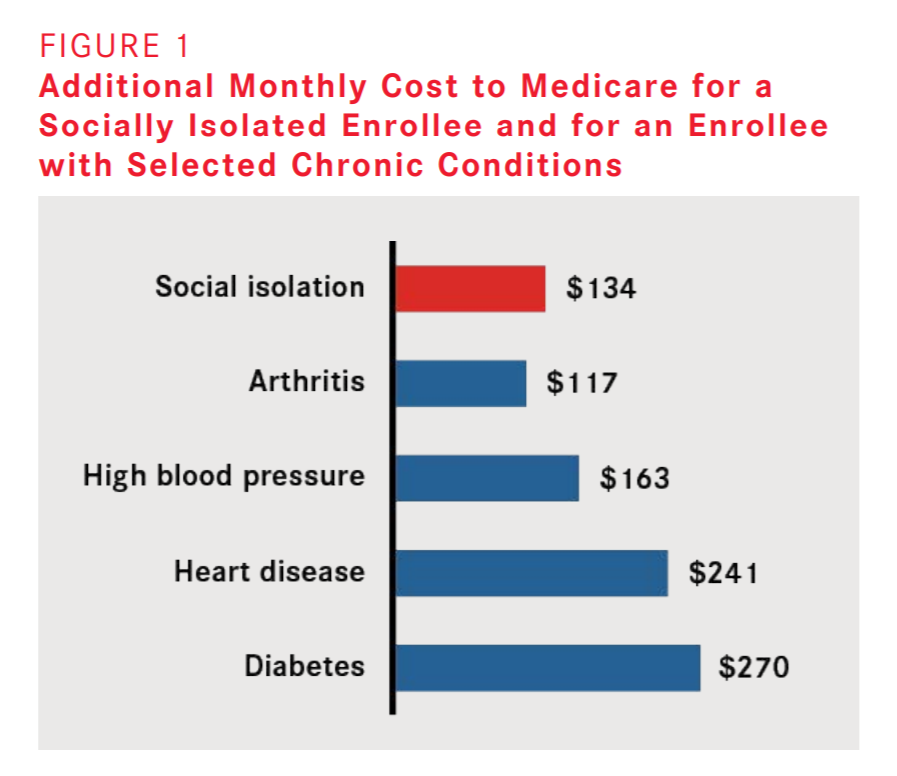In recent years, the epidemic of social isolation and loneliness (SIL) has garnered increased attention from researchers, policymakers and the public due to the long-lasting and sometimes detrimental effects SIL can have on a person’s health.

In addition to food insecurity, housing and transportation barriers, payers are beginning to address social isolation and loneliness as another major “driver of health.” The state of social isolation and the feeling of loneliness are different but related concepts. Social isolation refers to an objective measure of social connection and social networks—the quantity, not the quality of relationships. Loneliness is a subjective feeling about the gap between a person’s desired levels of social contact and their actual level of social contact. Social isolation can lead to loneliness and loneliness can lead to social isolation, but both may also occur simultaneously.
The distinction between these two concepts is often overlooked by policy makers and researchers, which poses a challenge when trying to understand how to help people reduce feelings of loneliness. According to a survey conducted by Cigna, nearly half of Americans report sometimes or always feeling alone. Another study conducted by the AARP found that nearly 20 percent of Americans over the age of 50 experience social isolation.
Figure 1: Those suffering from Social Isolation add more cost to Medicare than those who suffer from Arthritis ($117) but slightly less than those with High Blood Pressure ($163). AARP 6
SIL and health have a cyclical relationship. SIL leads to conditions such as: anxiety, depression, Alzheimers, cognitive decline, high blood pressure, heart disease, obesity and possibly premature death. Health complications such as mobility limitations, depression, cognitive impairment and hearing loss can lead to a person experiencing social isolation and/or loneliness. The result of this cyclical relationship is higher healthcare costs for all.
In a study conducted by AARP, it was found that SIL leads to $6.7B (per year) higher Medicare costs. As shown in Figure 1, SIL costs Medicare more than they spend on Arthritis and slightly less than high blood pressure. These inflated costs and new Medicare regulatory flexibility are pushing payers to address SIL more aggressively.
Here are a few initiatives set forth by some of the largest payers aiming to address SIL in their member populations:
- Anthem/CareMore: Anthem and CareMore have launched a “Togetherness Program” aimed at identifying and reducing loneliness among senior patients. CareMore views loneliness as a treatable health condition that can be addressed through engagement with patients and making it easier for them to connect with their communities. CareMore conducts regular phone calls, house visits, and connects members to community resources to those who experience loneliness. They claim hospital admissions for those who participate in the program were 21% lower than a comparison group.
- UnitedHealth: UnitedHealth has expanded their Navigate4Me program for those who are experiencing social isolation. Those in the Navigate4Me program receive concierge services from health navigators who support and guide people through the complexities of a the health care system
- Humana Bold Gold Program: In 2017, Humana started screening MA members for loneliness. Through their own research, they found that Medicare members who experience loneliness have up to twice as many Unhealthy Days (which measures self-reported mentally and physically Unhealthy Days of an individual over a 30-day period) as those that do not experience loneliness. Humana is pushing to decrease the number of Unhealthy Days of its members. In order to reduce loneliness, Humana has launched a pilot with Papa (see below) to connect college students with their MA population.
- CVS/Aetna “Resources for Living”: Aetna uses claims data and information collected on social determinants to identify members who are at high risk of becoming socially isolated. For their Medicare Advantage members who they identify as at risk of becoming socially isolated, Aetna has created the “Resources for Living” that allows for members to get connected to volunteer opportunities in their communities, take classes in areas that they are interested in, and helps them enroll in programs such as Silversneakers.
In addition to payers launching their own programs to address SIL, below is a list of healthcare startups that payers are using to hone in on the issue of SIL in their member populations:
- Papa: Papa connects college students and nurses with seniors to prevent loneliness and help with household chores.
- Mon Ami: Mon Ami has created a marketplace to connect college students with seniors to help with everyday tasks.
- Intuition Robotics (Elli-Q): Intuition Robotics has created Elli-Q, a social companion designed to ease feelings of loneliness in the lives of older adults
- Cuida Health: Cuida Health created a verbal social network in which the utilization of Amazon Echo monitors the health related activities and cognitive abilities of seniors, enabling them to remain in their homes longer.
- Rendever: Rendever has created a VR platform that helps elderly people to improve their mental health by allowing them to “travel” with virtual reality.
- Fitbit: With Fitbit, researchers were able to detect loneliness and social isolation through passive data collection.
- Pyx Health: Pyx Health created a chatbot that reduces loneliness and social isolation by connecting with members outside of the traditional care setting and promoting behavioral health through evidence based interactions.
- Catalia Health: Catalia Health has created a healthcare social robot. The company’s platform completes daily check-ins with patients to help them manage care routines and overcome the challenges of isolating illnesses.
- Riley: Riley has created an application that allows those with the same isolating health conditions to connect with one another
- Televeda: Televeda has created a platform intended to provide virtual care to seniors.The platform provides live streaming educational and wellness classes enabling older communities to participate virtually, lowering social isolation.
- Nesterly: Nesterly has created a digital marketplace that matches older homeowners who have a spare bedroom with young people, reducing their social isolation and loneliness.
- Silvernest: Silvernest has created a proprietary matching tool that pairs boomers, retirees, empty nesters and other aging adults with compatible long-term housemates to reduce loneliness.
- Concha Labs: Concha Labs has created a platform that enables users to try, buy, and tune hearing aids in real-time, reducing loneliness caused by hearing complications
- Mindstrong: Mindstrong is creating a platform that can passively detect cognitive changes based off interaction with the Mindstrong app.
- Reemo Health: Reemo Health delivers remote monitoring, embedded engagement, and a personalized support gateway as a ‘wearable-first’ platform. Designed specifically for the needs of rising risk populations, the Reemo lifestyle technology uniquely meets and engages consumers throughout their health journey.
What do we recommend? …Buy!
There’s a lot of investment opportunity in unique tech-enabled services such as Papa that can address multiple “drivers of health” through one service. Additionally, there will be opportunities that allow payers to save on the high administrative costs that come with the launch and maintenance of their programs to address SIL and other drivers of health.
As enrollment in MA plans increases, plans can either expand their administrative staff or look to automate the staff’s functions. As described above, Aetna is a good example of how organizations can use their team of staff members to connect their MA members to community resources. Payers will look to cut administrative spending by investing in tech that identifies which social programs they could offer in the counties where they have active plans, quickly onboard the non-medical services in those geographies and then match those services to members.
Want to read more of our research? Download the Food as Medicine Whitepaper to learn about:
- The challenges our health system is currently facing when it comes to cardiometabolic disease
- How using food as medicine can drive dietary modification to reduce cardiometabolic disease
- Jumpstart’s take on where we think this industry is headed
Other great resources on social isolation and loneliness:
- AARP “Connect2Affect
- Aging 2.0
- GreatCall Whitepaper
- Humana’s Loneliness Resource Toolkit
- Robin Caruso’s (Chief Togetherness Officer of CareMore) Twitter
Works Cited
- Abedini, N., Solway, E., Piette, J., i Malani, P., Cross-Sector Collaborations To Decrease Loneliness And Social Isolation In Older Adults. (2019). Health Affairs. https://www.healthaffairs.org/do/10.1377/hblog20190618.629601/full/
- Cigna (2018) https://www.cigna.com/newsroom/news-releases/2018/new-cigna-study-reveals-loneliness-at-epidemic-levels-in-america
- Framework for Isolation in Adults Over 50. AARP. (2012). https://www.aarp.org/content/dam/aarp/aarp_foundation/2012_PDFs/AARP-Foundation-Isolation-Framework-Report.pdf
- Social isolation, loneliness in older people pose health risks. NIH. (2019). https://www.nia.nih.gov/news/social-isolation-loneliness-older-people-pose-health-risks
- Fighting Social Isolation Among Older Adults. Greatcall. https://www.greatcall.com/docs/default-source/newsroom-files/fighting-social-isolation-among-older-adults.pdf
- Medicare Spends More on Socially Isolated Older Adults. AARP. (2017). https://www.aarp.org/content/dam/aarp/ppi/2017/10/medicare-spends-more-on-socially-isolated-older-adults.pdf



